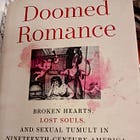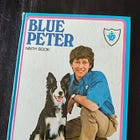The Princess's Present
THROWBACK/BIT OF HISTORY Random Stuff From Annette's Collection: A Crowdfunded Royal Gift for Millions
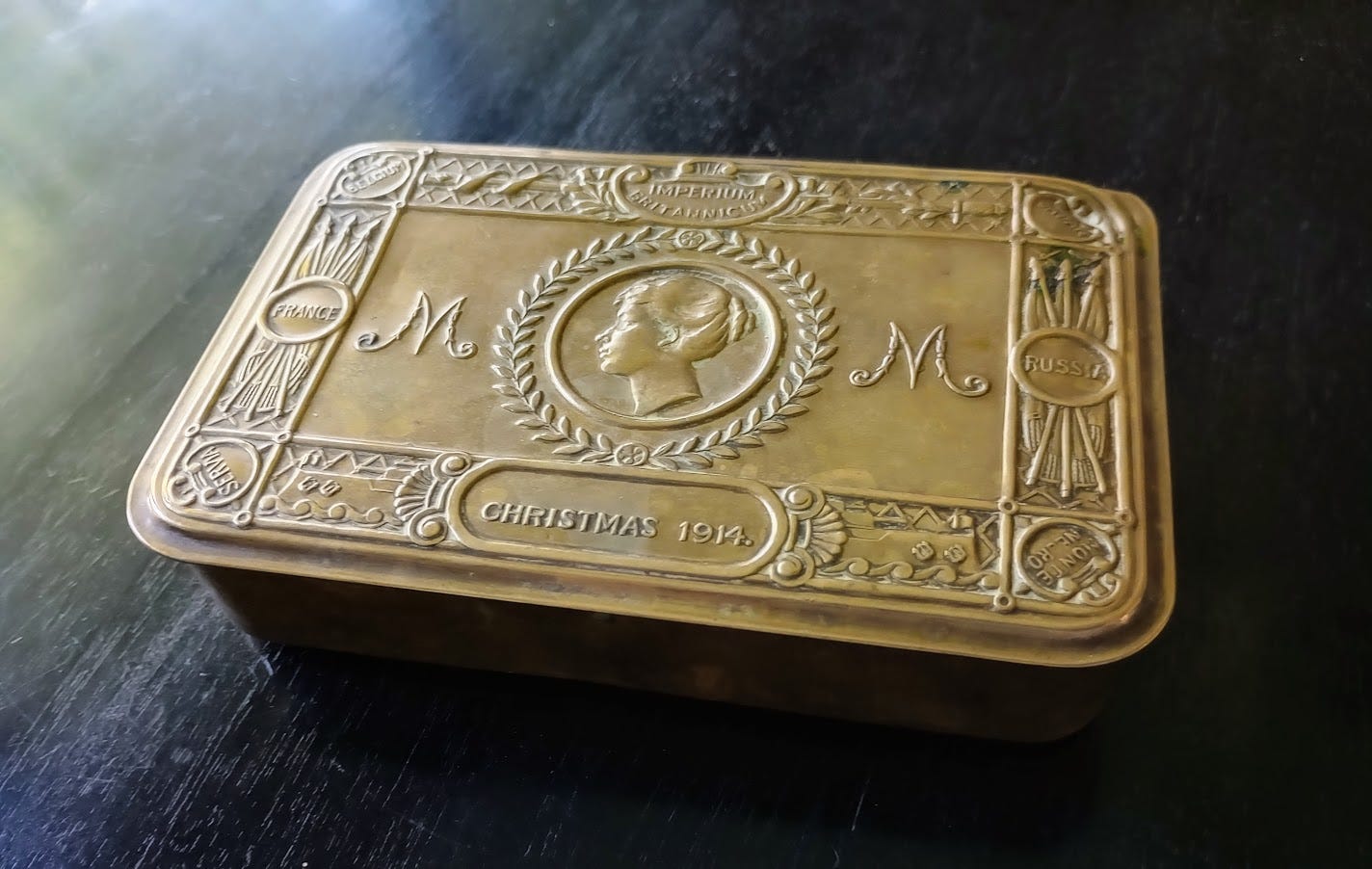
"I want you now to help me to send a Christmas present from the whole of the nation to every sailor afloat and every soldier at the front.
— Britain’s Princess Mary, age 17, 1914
Note from Annette (August, 2024)
Paying subscriber? There’s a voiceover link at the top of this post, recorded live, so you can hear me read it (plus asides, including me yelling at a woodpecker on the window)
NOTE: So the clock ran down, even as I have been working frantically on exciting future posts: I’m off getting me cataracts done this week, so please don’t be alarmed by the Throwbacks I will be throwing back at you over the next week until I can see again, and there will be fresh, tasty new material, thrown in, it just will be on the lighter side.
Meanwhile, I am hopeful that today’s post is either new to you, OR you’ve forgotten about it.
Her Late Majesty the Queen had died the previous year, and I was very much still in mourning. So royals were on my mind.
Odd how someone you have never met can be such a presence in your life, like Her Majesty Queen Elizabeth, and Her Royal Historian Dr. Christine Heyrman, Bancroft Prize winner, and my academic grandmother, whom I have never properly met, appearing in September at Non-Boring History. Send your questions or anything you want me to tell her on your behalf, Nonnies (paying subscribers)*
*Dr. Richard Godbeer, my PhD adviser, and Christine Heyrman’s PhD advisee, says he is quite worried that Dr. Heyrman might not appreciate my referring to her as “Granny” in my post on her book, Doomed Romance. I don’t see why. I think it’s rather sweet! 😍Unless and until a burst of death rays is sent my way from Maryland, I am going to assume she doesn’t mind! Ahem.
Don’t know what that’s about? This one. My best post ever for those in search of funny.
Note from Annette (August, 2023) Shopping on Diagon Alley
I don’t remember when I found this object exactly, maybe eight or ten years ago, but I do remember where: I was back in London, window-shopping on Cecil Court.
Cecil Court is a short pedestrian street, more an alley than a court, despite its name. Lined with antiquarian bookshops and antique stores, it’s reputedly the inspiration (or one of them) for Diagon Alley, the wizard shopping mall in J.K. Rowling’s Harry Potter books.
Something in an antique shop window caught my eye. Specifically, the brass tin in the photo above.
Oooh! I had never seen one of these in the flesh, not even a reproduction! And it cost . . . £100! Which was (wild guess) about $140 at the time.
Had this knick-knack only appealed for my own enjoyment, the story would have ended there. As an antique collector, I’m a very low roller.
But it wasn't for me. I was putting together my in-school presentation/author talk thingy on World War I, to go with my novels, two of which connect to the Great War, and I needed props to show the kids.
This tin got me all excited because I’ve been fascinated by Royal gift tins for British troops (which is what this is) almost all my life.
That sounds weird, but I can explain! As a kid, I watched an episode of BBC’s Blue Peter that was all about the original soldiers’ Xmas gift tin. Queen Victoria sent it in 1900 to soldiers fighting in the Boer War. It contained chocolate, much of which presumably arrived in South Africa as soup. Shiny object? Chocolate? Interested! And that interest extended to the gift tins the Royals sent to troops 14 years later, during World War One. Like this one.
But this time, it wasn't usually filled with chocolate.
What’s Blue Peter, what does it have to do with history education, and why could it matter to Americans now? Find out here, from this Bit of History post:
In triumph, I pushed open the door of that London shop, setting off the tinkling bell that announced “Dr. Laing is here to help you pay the rent, Mr. Antique Dealer!”, and I rammed my credit card in his general direction,
Oh, dear. The following year, I found an identical tin for sale at a Second World War re-enactment weekend in the North of England. It cost £35, about one-third the price of my first tin. Sigh. I bought that one as a back-up tin. The one you see here, though, is the expensive London original, earning its keep. Lesson: Don’t shop for antiques in London.
More Antique Advice (Barbie Movie Edition)
Okay, for anyone, especially but not only young women, discovering an inner feminist after watching the Barbie movie (which I haven’t seen yet*, despite my Sacramento connections and two degrees of separation from Greta Gerwig)
*Still haven’t seen Barbie, but I have plans. A.
Let me give you a useful tip for dealing with unpleasant antiques dealers from my very first solo shopping encounter with a London antiques dealer. I was nineteen, and unaccompanied by a serious-looking older adult male shopper. I asked to see a little knick-knack from the window, thinking of it as a possible gift for an American friend who was an avid collector and a bit of an Anglophile.
“Are you a collector?” asked the dealer in an unmistakably snotty tone.
“No,” I said, “this is for a friend.”
“Does he collect these?”
“Oh, he collects everything,” I said pleasantly. That wasn’t far from the truth.
“Well,” said the dealer, sneering openly now, “this will be a proper little godsend for him, then, won’t it?”
I’m very proud of what I did next. I gave him a hard stare (thank you, British WWII ladies, like my teacher Mrs. Betty Seale, who taught me and Paddington Bear that trick), handed it back like a hot potato with a curt “Thank you”, and exited.
It took me about five minutes to stop shaking as I walked back down Piccadilly. I’m not courageous, as you may have figured out. Just influenced by Scary Old Bags. Now I’m a Scary Old Bag. Alas, that just makes me more eligible to be hanged as a witch. I prefer hanging in there.
Laing, Get On With It. So What Is This Thingy?
It’s one of many little tins made from heavy solid brass, and filled with useful gifty things, that was presented to everyone who served the British Empire during World War One. But, as we’ll see, that's not the most fun part of the story.
The top of the tin is embossed with Princess Mary’s head, her monogram on either side, the words Christmas, 1914. below. At top is the Latin for British Empire, and in each corner, the names of British allies in the War in 1914: Russia, France, and also little Montenegro and Servia, both in the Balkans.
Despite being teeny, these two got equal billing with France and Russia. During the war, Servia’s spelling in English was corrected to Serbia to make it sound less servile. That's interesting, because the word servile (and servant) comes from Servia, like the word slavery was derived from Slavs, who I don't think are ever called Slabs. Still, this word history gives you some idea of the historical state of human rights in that part of the world.
My tin, like all such tins that come up for sale, came empty, and no wonder: The gifts were perishable, and they were used, and the other contents were paper, fiddly, and easily lost. But because lots of World War I re-enactors want the whole set, I was able to buy a repro of the packaging of typical contents (no, there’s no tobacco or cigarettes in the packets!)
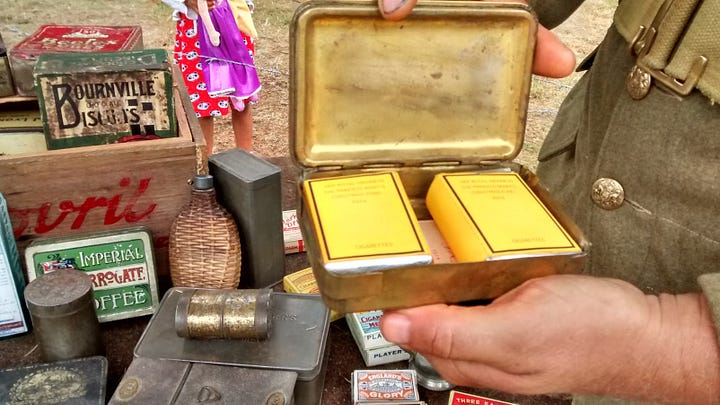
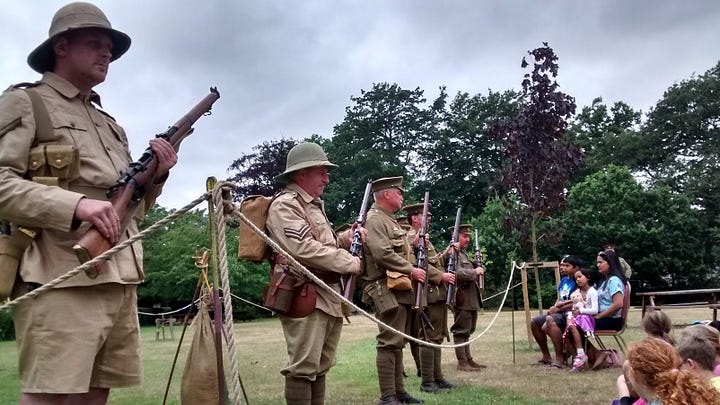
Here’s a photo of my tin and my fake contents:
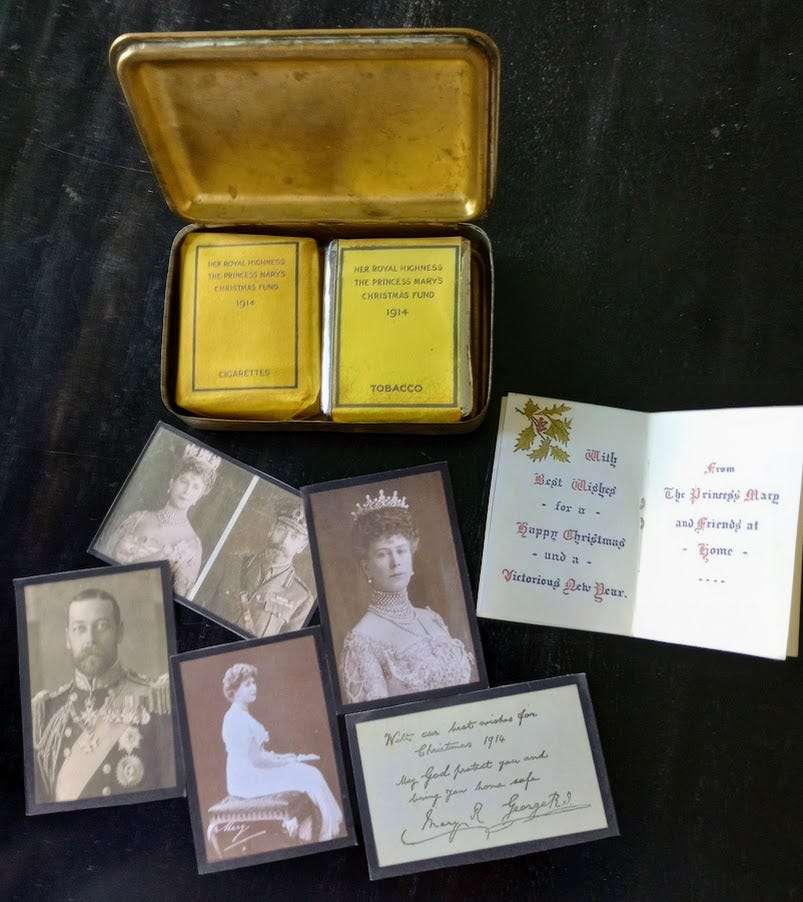
Included in most tins were a handwritten greeting from the King, wishing the recipient a happy Christmas. This seems overoptimistic, but a kind of happy Christmas actually happened for some soldiers in the trenches, when they had an unauthorized truce for the day, and sang carols and even played football with the Germans, before returning to killing each other the following day.
The King’s greeting also offers what seems now a second forlorn hope, given the horrendous battlefield casualties of the war: “May God protect you, and bring you home safe.”
I trust most soldiers appreciated the sentiment. By the time these tins were even thought of, in Autumn, 1914, while the truth didn’t start to dawn on the public until the following year, the Army was figuring out that this would be like no other war. A horrific bloodbath. One of my great-great uncles, like many in the regular Army, was already dead, killed in the first month of the war.
The box’s photos are of the King and Queen together, the King in Army uniform, the Queen (definitely not in Army uniform) and Princess Mary looking lovely, which was undoubtedly the most popular of the four.
There’s also a mini Christmas card from “The Princess Mary, and Friends at Home”. This didn't mean Princess Mary’s friends, but the public, who, as friends of the troops, had donated a small fortune to make this happen.
Little did anyone realize that these little tins would turn into one of the most challenging and successful operations of the War.
Operation Complicated Xmas (not actually its name)
In early October, 1914, two months after the First World War began, the story goes, Princess Mary, daughter of King George V and Queen Mary (King Charles III’s great-grandparents) had the idea of sending half a million troops and sailors a Christmas gift from her own pocket money.
I’m not buying that for reasons. Even Princess Mary didn’t have that much money, plus this wasn’t her original idea: Her great-granny, Queen Victoria, had sent the first royal gift tin to the troops of the Boer War, back in 1900. There was a meeting at Buckingham Palace early that month, attended by Queen Mary, the Princess’s mum, Prince Edward (the ill-fated future King Edward VIII, the one who married an American and almost brought down the monarchy, no, not him, the other one). Also present was Walter Peacock, one of Prince Edward’s staff, and I only mention him, because we’ll see him again. I guess Princess Mary was there, too, but it’s not clear to me that she was.
Anyway, voom, pow, this Royal group decides that the project is too expensive even for the Royals. I guess they learned something from the Boer War tins, which Queen Victoria paid for personally, at enormous expense, and probably had to mortgage one of the minor palaces to pay for it (okay, I made that last bit up).
One week later, a letter under the byline of Princess Mary, a winsome girl of 17, was published in newspapers. She appealed to the public for funds. I know, it sounds unlikely, but it's very possible she really did write it. It’s very cute. Here’s an excerpt:
"I want you now to help me to send a Christmas present from the whole of the nation to every sailor afloat and every soldier at the front. I am sure that we should all be happier to feel that we had helped to send our little token of love and sympathy on Christmas morning, something that would be useful and of permanent value, and the making of which may be the means of providing employment in trades adversely affected by the war. Could there be anything more likely to hearten them in their struggle than a present received straight from home on Christmas Day?
Please will you help me?"
See what I mean? The Princess’s appealing appeal set off a massive outpouring of generosity among ordinary Brits. Even kids donated £6,000 pounds in pennies, no small gift when a British penny bought a kid quite a lot of cheap candy: Even in my childhood, it got me a handful of toothrotting rubbish.
A little gift tin seems like a small thing, but it turned out to be an expensive logistical nightmare. And a triumph.
In the end, the project planned, made, stuffed and delivered 2.6 million of these things, far more than the half million originally planned. Good news? The crowdfunding campaign was a massive hit. Bad news? All that money had to be spent. In less than three months. Hint: Didn't happen on time.
While Princess Mary was the figurehead, a committee of nine posh people headed by the Duke of Devonshire was hurriedly convened in October, 1914, to oversee the project. They included the Prince of Wales’s staffer Walter Peacock, who was at the original Palace meeting with Queen Mary, and was now the Palace liaison, keeping the Royals informed.
Why was this even happening? Queen Mary was determined that her kids have visible roles in the War. The Royals always worry that people will think they're useless. But, unlike her brothers, Edward (future abdicated King, marrier of an American divorcee, and Nazi sympathizer) and Bertie (future King George VI, grandfather of King Charles III, star of The King’s Speech) Princess Mary couldn’t even put on a uniform and pretend she would be fighting in France.
This was 1914, and British women soldiers were not yet a thing.
Annette’s Aside: This is not the case more than a hundred years later, when Princess Anne, aka the Princess Royal, regularly rocks cool gender-nonconforming military uniforms, including one in which she looks like Admiral Horatio Nelson on horseback, while still identifying as the princess and woman she is.

Hey, any volunteers to ask Her Royal Highness if she considers herself nonbinary these days? I’ll wait. No? Nobody wants an ear Royally chewed off?
I would never want to sit next to Princess Anne at a dinner party (only because she’s terrifying) but she truly is the gift that keeps on giving. In a time when too many Brits have decided to trade in being interesting, and quietly doing valuable things, for shouting our identity thingies at each other, she is a great Royal role model for ignoring nonsense.
Are you offended by these comments? Please address your complaint to Non-Boring House’s Gnome for Diversity, Equity, and Inclusion, who will happily encourage your unhappiness.
In 1914, Princess Mary in a pretty dress was the Royal symbol of the tins, appearing on and in them. To be fair, she was not just ornamental: She was reportedly very excited by the progress of the project.
Crucially, the gift tin project was not just about the Royals, or poshoes like the Duke of Devonshire. It brought together thousands of ordinary people in manufacturing and in the Army, not to mention the generous donors. Everyone made this happen. It was truly a national project, and the surviving tins became beloved heirlooms in many families.
Not mine, as it happens: We lost four family members in the Great War. I think of my great-great-uncle Tom, who, as a member of the regular army and among the first shipped to France as cannon fodder, along with his brother, Bill. Bill was the one killed in the first month of the war. but Tom survived to see Christmas, 1914. He might have received a tin, but he did not bring it home before he was killed in the trenches the following summer. He didn’t bring home a tin so far as I know, that is. Which is not to rule out that he did bring one home, and another family member later spirited it away. More likely, though, he never got one at all, as we shall see.
Equity, Diversity, and Inclusion Tins
I was surprised to learn that the tins’ contents were customized. That's because the committee was soon aware that it was important to send suitable gifts to their diverse recipients.
First, something was needed for non-smokers instead of the standard tobacco and cigarettes.
Non-smoking soldiers got the tin, Xmas card, and other gifts, including a rather nice writing case with paper and envelopes in khaki, which you can see here. They also received a pencil in a pencil case shaped like the shells dropping on the battlefields, etched with an M monogram for Princess Mary, which seems a bit tasteless, but doesn’t seem to have bothered anyone.
And as money poured in, the range and diversity of recipients expanded. More thought was needed. Nurses, it was decided, should get Christmas tins. At this time, very, very few women smoked. Sure, they could have got the writing set, but some kind soul guessed they might prefer chocolate in their tins. Which was very thoughtful, if you ask me.
And this blew my mind: As funds made it possible to give Empire troops gifts, tins were customized for their varied cultural backgrounds.
However much we might disapprove of colonization, and long before diversity was cool, diversity was a hallmark of the British Empire. WWI British Empire troops came from the nations of Britain’s far-flung empire, from Canada, India, and the West Indies, just three examples.
And great thought was put into what Empire troops would receive. Servicepeople from predominantly British colonies, like Australia and Canada, got the standard gift. So did Gurkhas from Nepal and North India, who have long been a huge asset to the British military, even to the present day, long after the Empire has vanished.
However, Sikhs from India got hard candy and a tin of spices, while other Indian troops were given the spices, the candy, and the cigarettes. They also all got the Xmas card.
The Christmas card wasn’t as weird or insensitive as it sounds to Americans now, and I speak as someone who has often exchanged Xmas greetings with British Hindus and Muslims: The holiday is an important part of British culture.
Now I’m from Scotland, a nation where the Xmas holiday was not officially celebrated until well into the 20th century, because Scottish Calvinists—like the New England Puritans—considered it paganism. They certainly did NOT think that Jesus was the reason for the season. Christmas wasn’t a public holiday in Scotland until 1958, which sort of helps explain why Hogmanay (New Year’s) (although itself not a public holiday in Scotland until even later, 1974) was the bigger deal in Scotland. Partiers gonna party.
Maybe I shouldn’t be surprised that cultural sensitivity (Christmas aside) was understood to be very important in 1914: The Indian Rebellion (aka Indian Mutiny) against British rule in India had begun in 1857 with something given to Indian troops.
In 1857, rumors flew among Hindu and Muslim troops that their gunpowder cartridges, which soldiers opened with their teeth, were greased with either pig fat (offensive to Muslims) or cow fat (offensive to Hindus). This did not end well. And that kind of memory can become part of a culture: Even when we don’t realize the origins of what we do, we “remember” the past in almost everything we do and think. That’s why, when something we do or think appears suddenly and apparently out of nowhere, we might want to ask why that is. Just saying.
The gifts and brass boxes were extremely popular. So popular, the Committee had kind of made a monster.
Manufacturers had a hard time making such an impossible deadline, and in wartime, there were brass shortages. Deadlines were not met. Christmas 1914 came and went, with only some tins distributed. But despite massive casualties on the battlefield, demand grew. Every soldier wanted one.
The Committee scrambled for both alternate gifts, to replace those that the manufacturers struggled to produce in wartime, and even brass for the boxes.
They ordered about fifty US tons of brass strips from America to make more bloody boxes in 1915. Unfortunately, all that brass ended up on the floor of the ocean with the ship carrying it: It was loaded onto the Lusitania. You may have heard of it.
The biggest problem of all was getting the gifts to their recipients. The Army used a lot of men in the effort. Some troops didn’t get their presents until 1918, the year the War ended. Many, of course, missed out on their presents because they had died in battle. Not to sound flip, but I doubt that this was the soldiers’ worry as the bullets and shells flew.
Never Repeated
The best news was that after everyone in the military or associated with the war who was still alive finally got their boxes, there was a lot of money left over. Remaining funds were used to help fund Queen Mary's Maternity Home in London, founded by the Queen, and opened to serve military families. It opened in October, 1919, just five long years after that first meeting at Buckingham Palace. Out of death, life. The hospital remained open until 1975, and, last heard of, was a care home for the elderly.
You know, it’s a shame the Royals don’t send such Christmas gifts to the troops anymore. I can totally see Queen Camilla, a keen smoker, giving the thumbs up to sending everyone a packet of ciggies, and the King taking a keen interest in selecting organic, fair trade, yet non-melty chocolate for the troops. I expect the boxes wouldn’t be brass this time, but compostable cardboard.
But the massive headache it has been to make, assemble, and distribute . millions of Christmas presents was a lesson. Still, how much joy and love the little tins brought, to those who served in WWI, and to their descendants around the world, who cherished these Royal keepsakes, and still do. That's what makes them expensive and hard to find.
Want to Know More?
My sources on this are very readable for interested Nonnies. Check out this page from London’s Imperial War Museum. And this page by geologist turned author of military history Peter Doyle. He also has an entire book (lots of pictures) on the gift box.
Want your own tin?
Beware cheap, shiny, lightweight repros. If buying online, confirm that it’s the real deal. It should look like mine. Read the fine print, and get something in writing about its authenticity before you buy.
Thank you for telling your friends about NBH, and signing them up to try it out!




